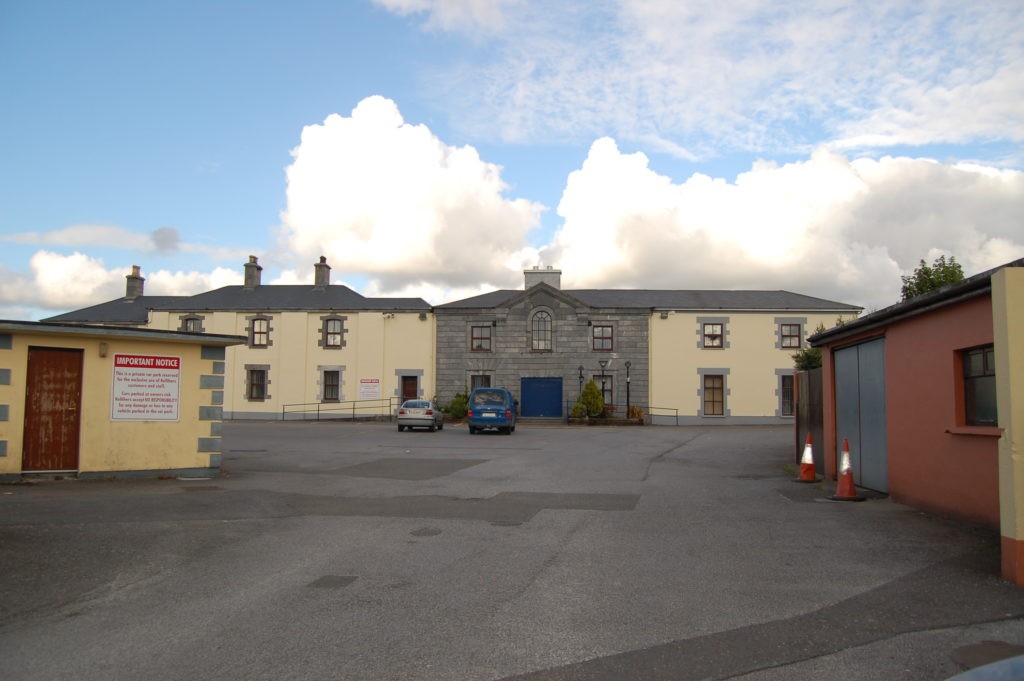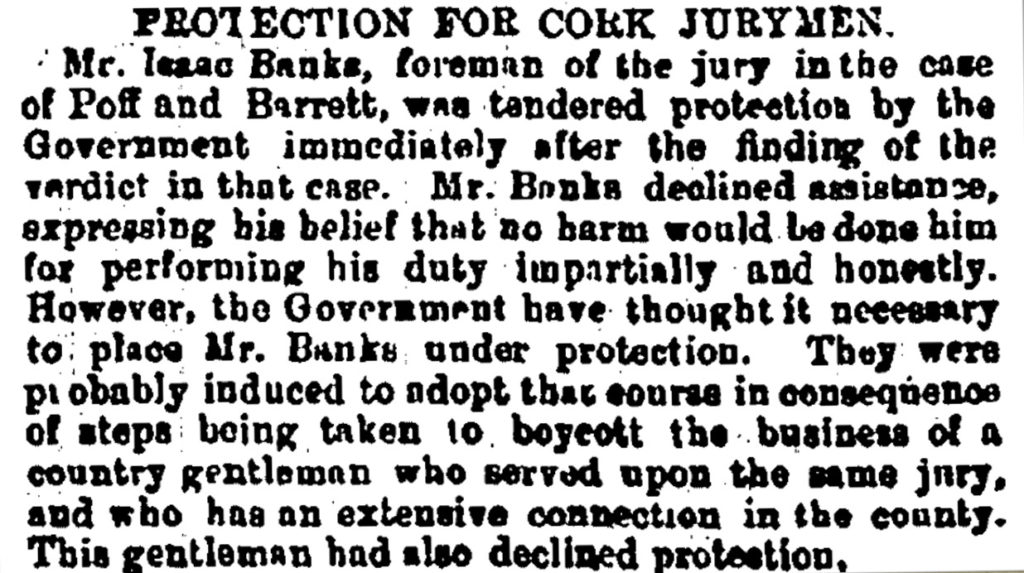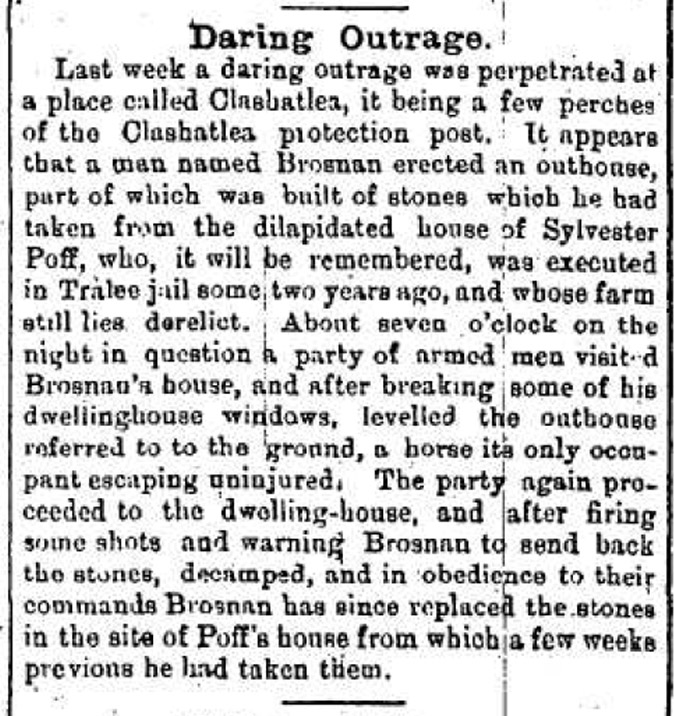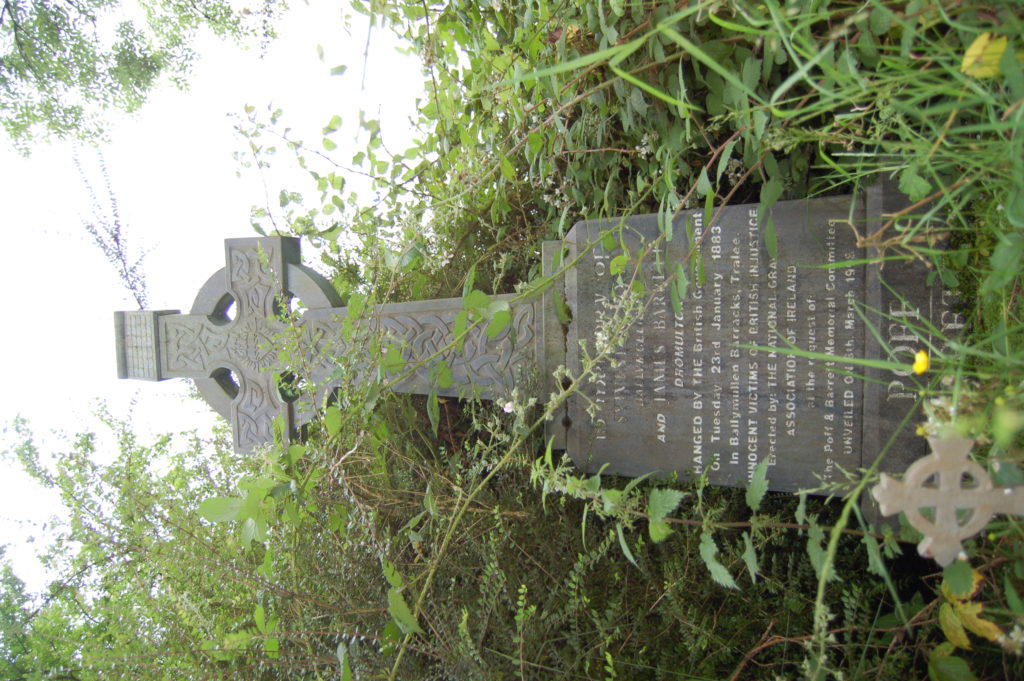Michael O’Donohoe’s papers include notes on the murder of Thomas Browne, shot dead on 3 October 1882, and the subsequent conviction and execution of his neighbour, James Barrett and Barrett’s cousin, father of four Sylvester Poff, for the murder.
Both men were widely believed to have been innocent.
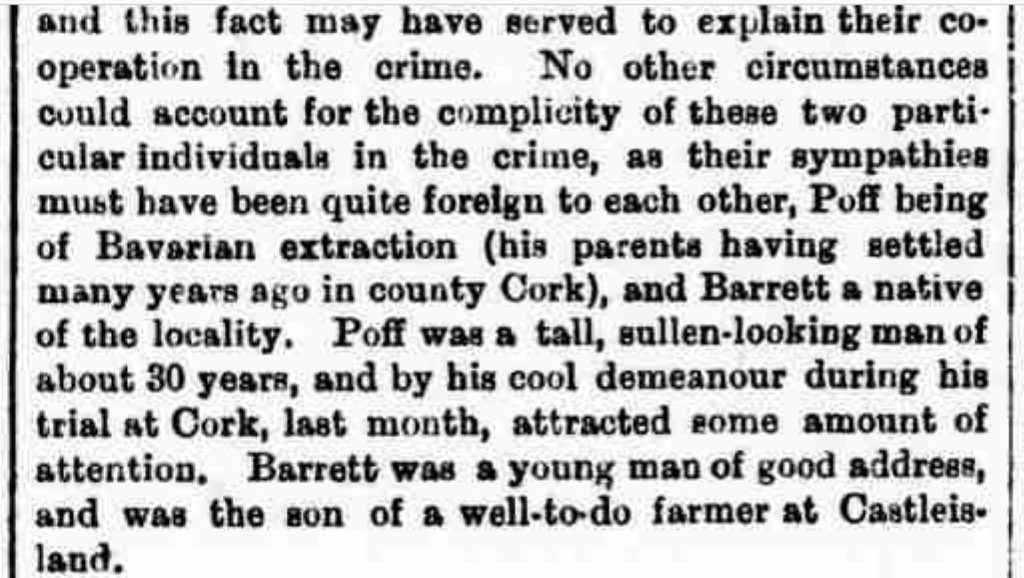
Poff and Barrett were hanged in the capstan mill yard of Tralee prison on 23 January 1883 at 8.05am; the press were not admitted to the execution or to the inquest.1 Edward Harrington of the Kerry Sentinel, who gained access as a juror, wrote that ‘publicity was obstructed to a degree never before witnessed in Kerry’:
The murder of Thomas Browne is avenged today but how can we dare to hope that it is not by a murder more awful … we despise the petty malignity which at the present time assumes the garb of law. We gazed on the last life blood oozing through those lips that had just disavowed guilt. We saw the efforts at excluding the guardians of public justice, the representatives of the press.2
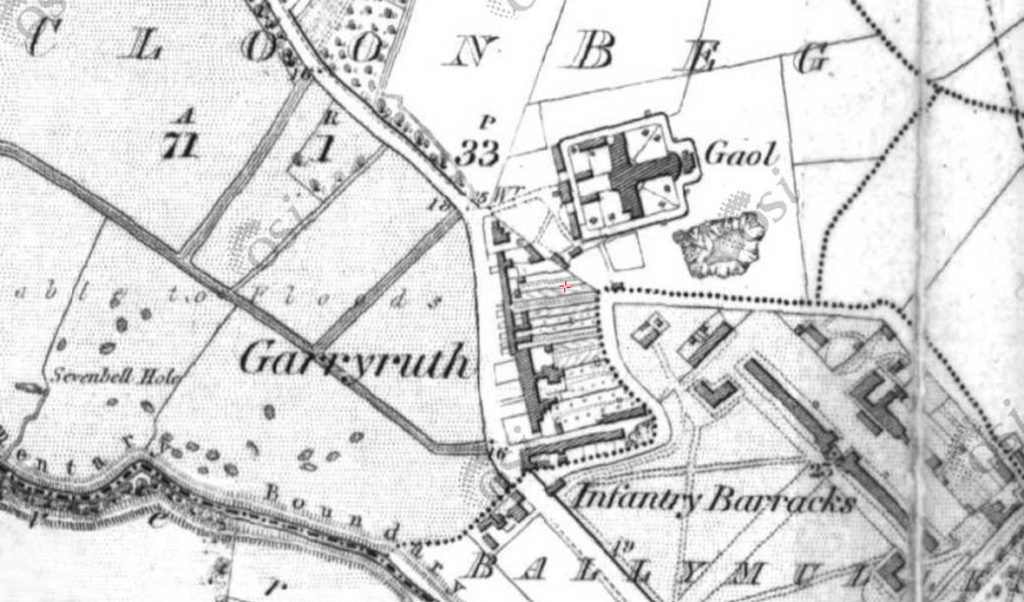
A report of the last moments of the condemned as Marwood, the executioner, prepared them for the scaffold, was pieced together:
When Marwood was loosening Poff’s shirt, he displayed the brutal feelings for which he has lately become characteristic by rudely inserting his fingers and tearing open the collar in a very rough manner. He acted similarly with Barrett … they proceeded slowly to the capstan yard to the rear of the main building. Here the scaffold was erected … Fathers O’Riordan and O’Callaghan were on the scaffold with them … The black flag to show that the law had been carried out was hoisted.3
Poff and Barrett, a seven-stanza verse in The Schools’ Collection, records the event and details of the parties involved:
Thomas Browne was a farmer who lived in Dromolton about four miles from Castleisland. He was suspected of having intended to grab the land of Paddy Sean Og. Thomas Browne’s assassins are not known but Poff and Barrett were charged with the crime … Poff was a native of Gortatlea and Barrett was from Drumolton.4
Collection material includes accounts of the murder from various sources including The Mysteries of Ireland5 and Donovan’s History:
A finer man than Mr Browne I never knew, physically or morally, he was a splendid specimen of an Irish farmer, a type of man that any country would be proud of … I am assured by an old Scartaglen moonlighter – an honest, intelligent, decent man, who ought to know, that Browne had never any intention of grabbing his neighbours farms. And if he had such an inclination, it can be stated at once that land-grabbing at that time was at an end – the moonlighters had made that certain. No one but a madman would then dream of grabbing his neighbours farm.6
It also includes a list of subscribers to a fund-raising appeal initiated by John Stack for the family of Poff. The Castleisland committee included Jeremiah Roche, Thomas Kearney, Maurice Murphy, Jeremiah Sweeney, Edmond Wren, Maurice K Hogan and Jeremiah Nolan. Edward Harrington of the Kerry Sentinel was among those who contributed and who also assisted in raising money by house-to-house collection.7
The hangings did not act as deterrent:
At Munster Assizes at Cork today, John Hussey, Timothy O’Brien, Michael Hanafan, John Buckley, and Michael A’Herne, all young men of the farming class, were indicted on a charge of unlawfully assembling while wearing disguises and carrying arms at Castleisland on the 26th September. Each pleaded not guilty. This was a moonlighting case in which the prisoners were captured by the police in the main street, Castleisland, where the disguises were found concealed in a bag.8
Remember Poff and Barrett
In 1884, Earl Spencer visited Tralee. The most noticeable feature of his visit was reported to be ‘the repetition of the insult that was offered at Castleisland by the hoisting of a black flag from the rooms of the Young Men’s Society, the words ‘Remember Myles Joyce’ painted in large yellow letters on one side, and ‘Remember Poff and Barrett’ on the other’.9
Twelve years after the executions of Poff and Barrett, John Twiss suffered the same fate. In his speech from the dock, he compared his plight to theirs:
Like Poff and Barrett, when I am dead and gone I am no loss at all … The two men that killed Poff and Barrett are over in the free land of America and whatever way they are over they can’t expect to be good or lucky … Poff and Barrett were found guilty of murder and hanged in Tralee. I am found guilty of the Newmarket murder and will be hanged in Cork.10
The Poff and Barrett Story by the former editor of the Corkman, Patrick Lynch, was published in instalments in the Kerryman in 1955 and 1956.
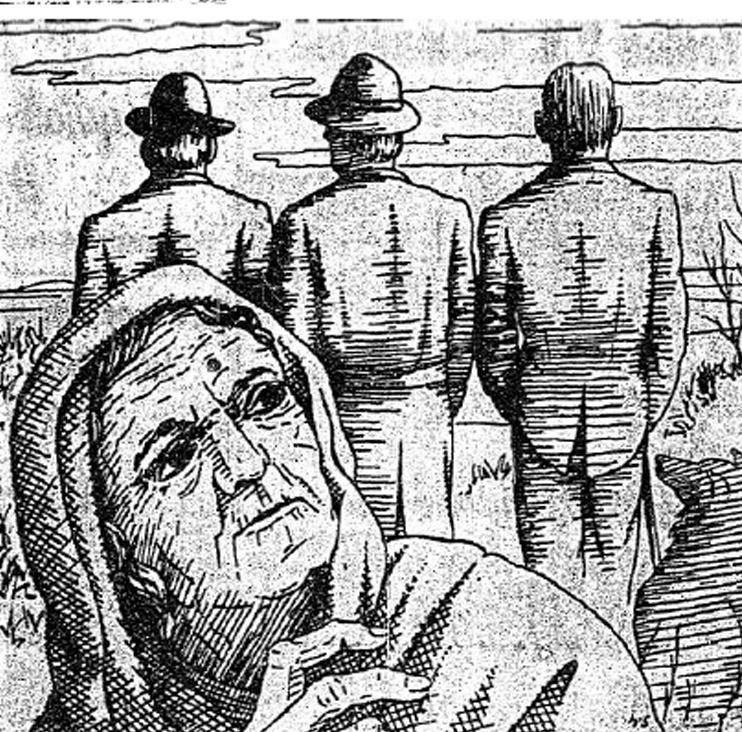
It included a song in four verses, A Poff and Barrett Ballad, which concluded:
And who can say what thoughts were theirs of whether their minds went back,
Across the hills and vales of Cork to a well-remembered track,
O’er a mountain slope where, in days gone by, they watched the sun go down,
And throw long shadows through the vale, where Castleisland town
Held fast to Fenianism and nursed the Land League seed;
Where, as years went by, there did not die the dauntless Moonlight breed.
A celtic cross memorial to Poff and Barrett was erected at Dromulton by the National Graves Association in 1998.11
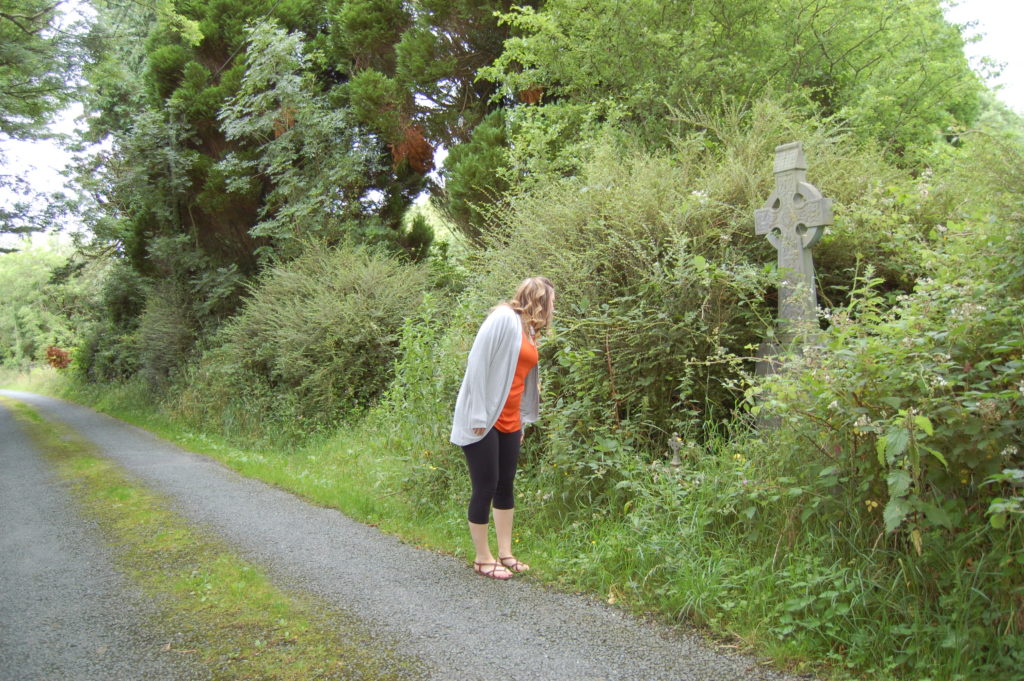
It is inscribed:
In memory of
Sylvester Poff
Ballymcelligott
and James Barrett
Dromulton
Hanged by the British Government
on Tuesday 23rd January 1883
in Ballymullen Barracks, Tralee.
Innocent victims of British injustice
Erected by: The National Graves
Association of Ireland
at the request of
The Poff & Barrett Memorial Committee
Unveiled on 8th March 1998
______________________________
1 There had been no hangings there for 30 years. Ballymullen prison closed in 1920 and was used as a military prison until 1925 when it was handed over to the local authority. Kerry County Council subsequently utilised the premises as a machinery depot. In 1995, Dick Spring launched the Lee Valley Action Plan which incorporated the redevelopment of the prison site. Kelleher's Electrical, built on the site, incorporated the facade of the old jail. It was reported in 1996, 'Since the gaol is a preserved building, every care is being taken to conserve its unique character'. In a letter to the Kerry's Eye newspaper in 1999 (19 August), Peter Locke sketched the history of the prison, built in 1812, and recalled some of those who died there: 'tons of concrete and tarmac now cover their resting places'. 2 Kerry Sentinel, 23 January 1883. 3 Ibid. Both men professed their innocence and Poff appealed for help for his children and family. 4 The Schools Collection (An Clochar, Castleisland), Volume 0447, pp171-174. Told by Mr Brosnan, Moloughmarkey to Nellie O'Connor. Mrs Browne died in March 1911. Mrs Poff died at Castleisland on Good Friday, March 1910; two of her children predeceased her. A daughter Elsie married Mr T Lawlor of Lower Main Street, Castleisland. Poff's mother (aunt of James Barrett and aged over 90) was still living in 1910. James Barrett's sister married Daniel Daly and died at Dromulton aged 84 in 1953. Executioner William Marwood of Horncastle, Lincolnshire, died on 4 September 1883. 5 Note on this book, published anonymously in 1884, in IE MOD/41. 6 Donovan added, 'The assassin’s bullet and the police lust for a victim caused the deaths of three fine Irishmen, ruined more than one happy home, soiled the souls of a few witnesses, and put three others under the risk of eternal damnation'. 7 IE MOD/86/86.3/86.3.1. A list of subscriptions from exiled Kerry people was published in the Kerry Independent, 30 July 1883. Poff's dying wish had been for help for his family. 'Poff leaves a wife and four young children ... and an aged mother and two adopted children – children of an absent sister ... James Barrett [unmarried] happens to be Poff's first cousin. Everyone who knew him believes that he was thoroughly incapable of committing the crime for which he is to be hanged' (Kerry Independent, 22 January 1883). 8 Lancashire Evening Post, 10 December 1886. 9 Flag of Ireland, 13 September 1884. Myles Joyce was hanged in Galway on 15 December 1882 in a case known as the Maamtrasna Murders. The Castleisland Young Men's Society was founded by curate Rev James K Fitzgerald, Brosna 'for the moral and intellectual advancement of the young men of Castleisland' (see Kerry Sentinel, 7 February 1879). 10 Kerry Weekly Reporter,12 January 1895. Notes on John Twiss, IE MOD/77. As with Twiss, a confession was made to the murder for which Poff and Barrett were condemned by a man named Boder though it was not taken seriously (Kerry Weekly Reporter, 16 August 1884, 'The Scartaglin Murder'). 11 'A memorial will be unveiled at Dromulton, Currow on March 8 at 11am to the memory of Poff and Barrett. A collection was carried out in 1968 to erect a memorial ... in March 1997 this money was handed over to the National Graves Association of Ireland by the Poff and Barrett Committee ... On the first Friday of March a Mass will be said in Currow parish church for Poff and Barrett at 7.30pm. Signed John Houlihan, Kerry Representative for the National Graves Association of Ireland' (Kerryman, 27 February 1998).


